
Up Down and All Around
 For the last four months I have been working on a traveling display of my concepts for the H.O.P. (Hands-On Partnership) for Science, Literature and Art in South Dakota and the Discovery Center in Pierre. The display goes into a trailer which is checked out by libraries and schools around South Dakota. They set the display up and use it for a month. It has many hands-on exhibits or stations for students to explore different ideas. UP DOWN AND ALL AROUND helps students see and learn about the orders of total visual space.
For the last four months I have been working on a traveling display of my concepts for the H.O.P. (Hands-On Partnership) for Science, Literature and Art in South Dakota and the Discovery Center in Pierre. The display goes into a trailer which is checked out by libraries and schools around South Dakota. They set the display up and use it for a month. It has many hands-on exhibits or stations for students to explore different ideas. UP DOWN AND ALL AROUND helps students see and learn about the orders of total visual space.
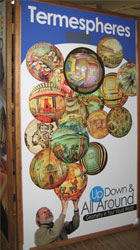 There are two original Termesphere spinning in holes in the entrance walls that invite you into this Exploratorium. There are four hinged walls that explain different parts of the display usually set up like corners of a cube that can be spread out to fit the size of the room it is in. Each of these walls are 4X7 foot.
There are two original Termesphere spinning in holes in the entrance walls that invite you into this Exploratorium. There are four hinged walls that explain different parts of the display usually set up like corners of a cube that can be spread out to fit the size of the room it is in. Each of these walls are 4X7 foot.
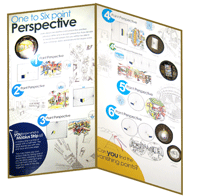 One of the stations is for students to explore ONE THROUGH SIX POINT PERSPECTIVE. The walls that contain this section show the grids used and some drawing results. There is also a DVD in the corner where I show students how to do all of these perspective systems.
One of the stations is for students to explore ONE THROUGH SIX POINT PERSPECTIVE. The walls that contain this section show the grids used and some drawing results. There is also a DVD in the corner where I show students how to do all of these perspective systems.
Another section has magnetic stick and steel balls for the students to put together to EXPLORE POLYHEDRA and THREE DIMENSIONAL GEOMETRIES. The goal is to help the attendees understand the total space around them by better understanding the geometries that fit in that total space.
The walls show the step by step processes of my workshop I do in this area. Also there is a DVD that shows students a step by step process to learn these basic building blocks of nature and man.
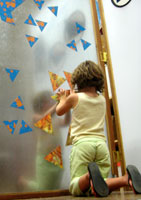
Polyhedra of the CAPTURED WORLDS are on a table for the students to fold up.
TETRAEARTH AND TETRA ART Flat and three dimensional puzzles coming from the Earth and Art on the tetrahedron are in this section. One of the 4X7 walls is made of sheet metal which allows the magnetic puzzle sheets to attract to. A complicated three dimensional puzzle of the Tetra Earth with 28 faces is part of this section. John Conway from Princeton suggested this polyhedron. The four triangles of the Earth repeat seven times to fill this puzzle which is made up of a tetrahedron coming out of a icosahedron. This is a great challenge for the students.
 THE MIRRORED BALLS hang in one section. I painted one ball with mirrored faces so they better understand they are always in the middle of the mirrored sphere. There are many questions that are on the wall to get them thinking.
THE MIRRORED BALLS hang in one section. I painted one ball with mirrored faces so they better understand they are always in the middle of the mirrored sphere. There are many questions that are on the wall to get them thinking.
THE TRANSPARENT SPHERE OF ST. PETER BASILLICA Questions:
- Why does spinning this sphere make your eye/mind see only the front or the back?
- Why do most people only see the concave or the back of the sphere when it is spinning?
- What happens to the direction the ball is spinning?
- Where are you located when you see the back side of the ball?
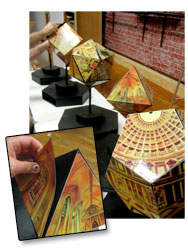 The TERMESPHERE DVD section has a wall of our environment and another of many spherical paintings.
The TERMESPHERE DVD section has a wall of our environment and another of many spherical paintings.
THREE DIMENSIONAL POLYHEDRON PUZZLES TO PUT TOGETHER Five 16″ in diameter, three dimensional polyhedron, of the icosahedrons, dodecahedron, octahedron, hexahedron and the tetrahedron are on tables in the center. Each is covered with total environment images coming from Termespheres. These puzzle images are in the shape of triangles, squares, and pentagons. The students job is to fill in the sides with the proper polygon images to make total environments. Magnetic sheets are used to hold the polygons to the different sides of the three dimensional polyhedron. This helps students to be able to see in three dimensional space, the up, down and all around space.
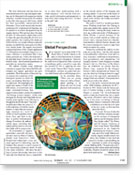 Science Magazine Artical about Termespheres
Science Magazine Artical about Termespheres
SCIENCE magazine just came out with an article on Termespheres called Global Perspectives. Barbara Jasny who is Deputy Editor of the Science visited the Gallery this summer. I was pleased with her excitement about my work. You can see her article by Clicking Here.
Hole of the Whole
Look for this sphere to be unveiled at the Dahl Fine Arts Center in Rapid City in March!
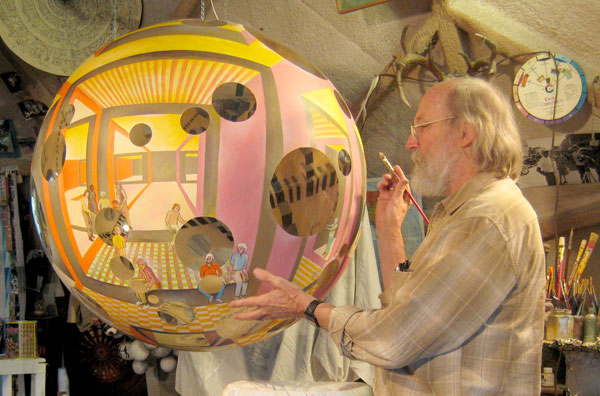

Discovering Perspective
DISCOVERING PERSPECTIVE is a new sphere that shows where perspective comes from:
This sphere has a cubical city in the round, 360 degrees in all directions. Square and rectangle canvases appear around the sphere showing the space of each of the different systems of perspective. This sphere makes you realize the same problems that map makers had when they tried to flatten the Earth into maps. These are the same problems we have when we try to draw the space around us on the flat surface. These photos show the different systems of perspective on the six point perspective sphere.

Click on this image to see all the perspective points.
True Perspective by Dick Termes
When people ask me about the rules of one and two point perspective I have a little trouble answering their questions. I think of the flat perspectives as being systems which do the best they can to replicate but the real world the real visual world is a sphere world. The same as the flat maps of the Earth, they try the best they can but they are distortions of the real thing. This is a very touchy area to be in because one and two point perspective have been around for 500 years and are thought of as very perfect systems.
I believe that all scenes that artists crop out of the world around them for their paintings are just that, a piece of the whole, the whole being the sphere or globe. So whenever artists want to know how to deal with flat perspectives I have to tell them it is a imperfect system. We must realize the images that are around us, if we tie them all together, would be best thought of as fitting on or in a sphere. Just because our eyes can see only about 160 degrees of our horizon we still know more is there. Stand in one spot and turn in a circle. Now standing in that same spot, turn again and look up and next, look down. Do you see that it is all tied together? How do we best map what you see and on what object? I believe the object that best fits that task is a sphere. When I paint my Termespheres I imagine I am inside a transparent sphere looking out at a world I want to paint. I copy that world onto the surface of the sphere. I then move to the outside to look at what I was inside of. When things fit as well as this, you know something is right. Nature’s answers are beautiful and so is the way these worlds fit onto a sphere. I do think of six point perspective as a discovery rather than an invention. The cubical six point perspective works very well. If all of the cubical world is parallel to each other, six points are all that are needed to capture that world. If a table is turned a little in that cubical world another four points are needed on the horizon line to take care of that twist. These points would be equally spaced pointss. If the table were turned 45 degree to the other cubes its vanishing points would be half way between the original points. There is a very tight system involved in spherical perspective that isn’t there in flat perspective. In spherical six point perspective, all lines are greater circles. All cubes within the scene project to all six vanishing points. The truest perspective probably would be found from within these spheres but some wonderful insights happens from looking at the outside of the spherical paintings
Rudy Rucker and Dick Termes
 A site I would like to draw your attention to is one by Rudy Rucker. He visited our place this summer . This was his second trip to our home and gallery. When he got home to his blog he wrote some very nice comments about visiting our world. I hope you will check it out
A site I would like to draw your attention to is one by Rudy Rucker. He visited our place this summer . This was his second trip to our home and gallery. When he got home to his blog he wrote some very nice comments about visiting our world. I hope you will check it out
Markie pointed out that some of you may not know who Rudy Rucker is. In short, Rudy is quite a guy. So I could be sure to cover as much of his genius as possible, I headed over to Wikipedia and grabbed this snippet from his entry, “Rudolf von Bitter Rucker (born March 22, 1946 in Louisville, Kentucky) is an American mathematician, computer scientist and science fiction author, and is one of the founders of the cyberpunk literary movement. The author of both fiction and non-fiction, he is best known for the novels in the Ware Tetralogy, the first two of which (Software and Wetware) both won Philip K. Dick Awards. At present he edits the science fiction webzine Flurb.”
27,500 Look at Termesphere, Reflecting Back on YouTube
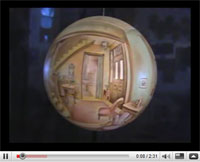 The YouTube video of the Adams House called REFLECTING BACK has drawn many hits from people. The optical illusion of this piece is one of its attractions. Even though the sphere is convex it seems to look concave when it is turning. It is as if you are looking at the inside of the ball. This happens with all of my spheres. An article in Perceptual and Motor Skills, 1991 by Al Brennan from South Dakota State University where he explained the illusion of the Termesphere. He called it the Termes Illusion. The world seems to be excited about it now.
The YouTube video of the Adams House called REFLECTING BACK has drawn many hits from people. The optical illusion of this piece is one of its attractions. Even though the sphere is convex it seems to look concave when it is turning. It is as if you are looking at the inside of the ball. This happens with all of my spheres. An article in Perceptual and Motor Skills, 1991 by Al Brennan from South Dakota State University where he explained the illusion of the Termesphere. He called it the Termes Illusion. The world seems to be excited about it now.
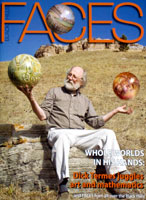 Black Hills Faces Magazine
Black Hills Faces Magazine
Black Hills Faces Magazine did a nice article on me. I even got to be on the cover…This was an article written by Kaija Swisher with photos taken by Mark Wanek and James Van Nuys. It was a rare article that gets into my personal world. I guess that is why they call it FACES FROM ALL OVER THE BLACK HILLS. I was excited about this magazine article. They do have extra copies of this at www.blackhillsfaces.com
Thank you for reading to the end
I hope some of my thoughts and new ideas will get some comments back from you, positive or negative.
I love the way some of my math friends are making suggestions of concepts for me to consider. As always, thank you for your tremendous support and encouragement. I would love to hear what you think.
Feel free to call at 888-642-4805 or email me termes@blackhills.com